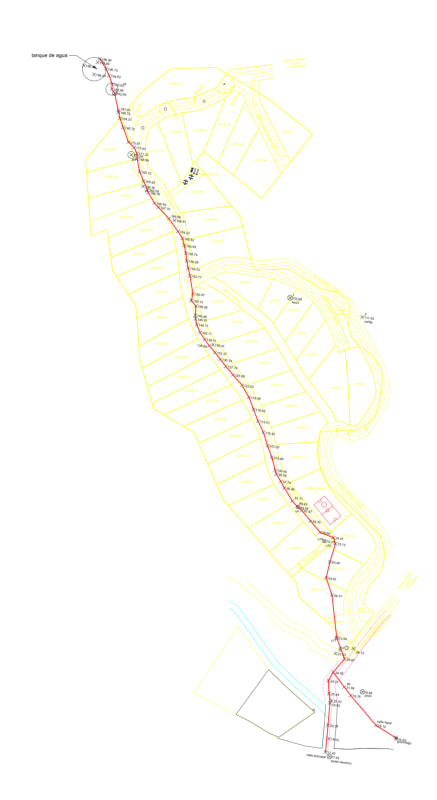Pozos_panama
Mechanical
Hello everyone, first time poster here so thanks in advance!
I have recently been asked by a potential client to assist in designing a water distribution system for their development. Their basic concept is to pump water from a well (labeled pozo in the picture at an elevation relative to sea-level of ~16meters) up to an area with reserve tanks (labeled tanque de agua at an elevation of ~196 meters) and then have a distribution pipe leaving the reserve tanks and feeding individual lots/houses.
The lots are all along the way and some will have relatively little elevation difference while others will see the full ~180m of difference.
For more background, we are in a remote area of Panama with typical materials relatively hard to find. Most places around here are just using glued PVC for their distribution systems, which brings tons of headaches and almost non stop maintenance/patching of the lines.
I was wanting to use HDPE pipe for this job however, with that elevation difference it puts the pressure at the bottom of the line at ~255 psi - above the rating of 200 psi HDPE (at least roll pipe). I was hoping to use roll pipe (2") because the fittings are relatively easy to get ahold of, don't require extra tools, and don't require specific training.
Question 1: The repeated surge pressure of 200psi pipe says it is up to 300 psi, but I am having a hard time finding the definition of what that entails. For example, if the line has check valves along the way, the hypothetical flow rate of 30 gpm doesn't add too much in losses (total length of client's desired path for line was about 768 meters which would add about 19 psi in losses), and it is pumping for a few hours a day. Does that fall into the repeated surge category or is that outside of it?
Question 2: The main distribution line will exit the reserve tanks and follow a road downhill with takeoffs for the different lots. Is it feasible to have a pressure reducing valve on the main line in order to ensure the pipe stays within it's pressure rating? Or would there have to be a second storage tank lower down the hill to act as a break? Or is there a better way that I am ignorant to?
Question 3: For long line runs down hills - sometimes quite steep - does there need to be some type of air venting available?
For more context: The developer has said that while there are going to be an initial 20 lots/homes built soon, with potentially up to another 100 over the coming years in further phases, they are all vacation/part time homes and he never expects there to be more than 40% occupancy at any given time.
Bonus question: Does anyone have a preferred brand of smart water meter/leak detector that has remote/auto shutoff capability?

I have recently been asked by a potential client to assist in designing a water distribution system for their development. Their basic concept is to pump water from a well (labeled pozo in the picture at an elevation relative to sea-level of ~16meters) up to an area with reserve tanks (labeled tanque de agua at an elevation of ~196 meters) and then have a distribution pipe leaving the reserve tanks and feeding individual lots/houses.
The lots are all along the way and some will have relatively little elevation difference while others will see the full ~180m of difference.
For more background, we are in a remote area of Panama with typical materials relatively hard to find. Most places around here are just using glued PVC for their distribution systems, which brings tons of headaches and almost non stop maintenance/patching of the lines.
I was wanting to use HDPE pipe for this job however, with that elevation difference it puts the pressure at the bottom of the line at ~255 psi - above the rating of 200 psi HDPE (at least roll pipe). I was hoping to use roll pipe (2") because the fittings are relatively easy to get ahold of, don't require extra tools, and don't require specific training.
Question 1: The repeated surge pressure of 200psi pipe says it is up to 300 psi, but I am having a hard time finding the definition of what that entails. For example, if the line has check valves along the way, the hypothetical flow rate of 30 gpm doesn't add too much in losses (total length of client's desired path for line was about 768 meters which would add about 19 psi in losses), and it is pumping for a few hours a day. Does that fall into the repeated surge category or is that outside of it?
Question 2: The main distribution line will exit the reserve tanks and follow a road downhill with takeoffs for the different lots. Is it feasible to have a pressure reducing valve on the main line in order to ensure the pipe stays within it's pressure rating? Or would there have to be a second storage tank lower down the hill to act as a break? Or is there a better way that I am ignorant to?
Question 3: For long line runs down hills - sometimes quite steep - does there need to be some type of air venting available?
For more context: The developer has said that while there are going to be an initial 20 lots/homes built soon, with potentially up to another 100 over the coming years in further phases, they are all vacation/part time homes and he never expects there to be more than 40% occupancy at any given time.
Bonus question: Does anyone have a preferred brand of smart water meter/leak detector that has remote/auto shutoff capability?


![[hairpull] [hairpull] [hairpull]](/data/assets/smilies/hairpull.gif)